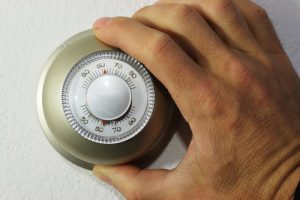 You could call this post “Summer Thermostat Best Practices,” although maybe that sounds a bit too business-like. Just think of this post as your short, simple guide to undo some bad habits many homeowners get into when it comes to setting the thermostat.
You could call this post “Summer Thermostat Best Practices,” although maybe that sounds a bit too business-like. Just think of this post as your short, simple guide to undo some bad habits many homeowners get into when it comes to setting the thermostat.
Have you ever done this? It’s a hot day, and you feel more flushed and sweaty than usual in your house. You go to the thermostat, notice it can go down to 60°F, and think, “I’ll crank this thing and get the maximum cool air from it,” then drop the thermostat setting to that lowest level. A short time later, it’s gotten too cold in the house, so you move the thermostat back up to where it was.
No shame in admitting if you do this. Now please, don’t do it again. This is not only a way to waste power, but it doesn’t reflect how the thermostat works or how your house becomes hot.
A Thermostat Is a Switch, Not a Throttle
This is the comparison we like to use to describe how thermostats work. They control whether the air conditioning system’s fan and compressor are on or off. Moving the thermostat lower doesn’t make the air conditioner labor harder to put out cooling, raising the amount of cool air blasting from the vents. What it does is instruct the air conditioner’s compressor to run for longer until the thermostat detects the house has reached the setting.
In our above example, 60°F won’t cool off the house any faster than any setting lower than the outdoor temperature. The AC will run until it registers 60°F—and that takes immense amounts of work for a temperature that’s too cold! Something else to keep in mind: air conditioners cannot lower a house’s temperature more than 20°F from the outside temperature. If it’s a 90°F day, the AC will never reach 60°F.
Slowing Down Heat Gain
Now that you know more about how the thermostat runs, let’s see how heat gain affects how the house warms up. Heat moves from an area of high concentration to lower concentration, and the bigger the difference, the faster the cooler area gains heat. If you lower your indoor temperature too far, the outside heat will enter quickly and you’ll have to keep running the AC. What you want to aim for is the smallest gap between your indoor temperatures and the outdoor temperatures. In other words, find the higher thermostat setting at which you’re comfortable.
A recommended temperature that works well for comfort on most summer days is 78°F. Wear light clothing and run the fans and you should have no problem staying comfortable during the day. Raise the temperature by 8°F at night. You can save from 5% to 25% on your bills with this wise thermostat control.
If your air conditioning in Fairfield, OH isn’t keeping your house cool enough no matter what you do with the thermostat, it’s time to leave the thermostat alone and call our experts to see if your HVAC system needs repairs.
Call Bartels Heating & Cooling “For a Comfortable Way of Life.” We have 24-hour emergency service available.
